1932
ROCKETEERS (1/30)
Direction: John Foster, George Rufle
 The Royal Experimental Society has selected volunteers Tom and Jerry to blast off to the moon in a rather small rocket. The Society chief (speaking in trombonese) expresses enthusiasm for the event and launches the rocket. Unfortunately, it does not make it to the moon, but rather heads down into the ocean. There, our boys encounter an assortment of fish. When Tom strikes the first, it shouts “Mama!” summoning several other bizarre sea creatures to the scene. Next our heroes meet a skeleton fisherman, who repeatedly catches and swallows a single fish, only to have it escape through his ribcage and get caught and consumed again.
The Royal Experimental Society has selected volunteers Tom and Jerry to blast off to the moon in a rather small rocket. The Society chief (speaking in trombonese) expresses enthusiasm for the event and launches the rocket. Unfortunately, it does not make it to the moon, but rather heads down into the ocean. There, our boys encounter an assortment of fish. When Tom strikes the first, it shouts “Mama!” summoning several other bizarre sea creatures to the scene. Next our heroes meet a skeleton fisherman, who repeatedly catches and swallows a single fish, only to have it escape through his ribcage and get caught and consumed again.
Tom and Jerry then enter a wrecked ship, filled with dozens of beautiful mermaids and an ugly caricature of Texas Guinan (special thanks to Cole Johnson for identifying this actress). Our boys sing Oh, How We’d Like to Own a Fish Store while an Irish finnan haddock and a Jewish “gefilte fish” dance in tune. Suddenly, Neptune signals the alarm, and a line is sent down by the Experimental Society scientists. When they reel it up again and find Tom and Jerry aboard, hugging a pair of mermaids, they release the line and jump in themselves, hoping for more of the same!
ROCKETEERS starts out strong enough (its trombone-voiced scientist sounds like a character from Zagreb’s COW ON THE MOON), but weakens once our heroes fall underwater. It really is quite a shame, since this could have easily become an otherworldly cartoon to rival the likes of Fleischer’s UP TO MARS, especially with all that Van Beuren surrealism on hand! As a final note, while plenty of Jewish animators must have worked at Van Beuren, one gets the impression that they weren’t consulted on ROCKETEERS‘ underwater sequences. Gefilte fish, as a single, mobile aquatic species, do not exist! Gefilte fish is really just a recipe that actually mixes several different kinds of fish.
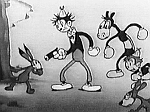 RABID HUNTERS (2/27)
RABID HUNTERS (2/27)
Direction: John Foster, George Stallings
It’s a peaceful morn in Tom and Jerry’s rural neighborhood. Snoozing in bed, Tom is awakened by a bird pecking on his alarm clock. Then Jerry is awakened by Tom blowing a horn; it’s hunting day for our heroes. Their dog Dawg joins them from his doghouse. Next, their goofy horse dresses and emerges from his stall. The gang gallops for the woods, called by other hunting horns — but when their first prey, a duck, appears, it catches them off guard. The bird knocks our boys off their horse, eludes Tom’s efforts to swat him with his rifle, and finally hides inside the gun’s barrel, sabotaging it from within.
A rabbit is Tom and Jerry’s next quarry. Dawg pursues him to his hole, but the heckling hare zips the hole up! In Dawg’s haste to sniff around the area, his nose separates from his snout — but when the rabbit hits the disembodied nose with a club, Dawg feels the pain anyway. Tom, Jerry, Dawg and the horse all sniff around the area, then emerge from a multi-trunked dead tree to swat at the bunny, hitting one another instead. Similar bad luck prevails when tracking the rabbit in a pond: the long ears the horse grabs are only Dawg’s. The rabbit dodges Tom atop a stream of water, then does some log-rolling with a log holding all our heroes.
The characters next chase around and behind a tree’s branches, with the rabbit playing his lips like a trombone. Everyone falls to the ground and Tom recovers first, pointing his gun at the hare — who now reveals he’s really a skunk in a rabbit suit. Sprayed with stink, our heroes head for the hills.
RABID HUNTERS reveals its studio at a crossroads. The short’s gentle opening and round visual style suggest less the anarchy of early Tom and Jerry and more the softness of later Van Beuren shorts. But the wild gags of the cartoon’s climax hark back to Disney’s FOX CHASE (1928) and ahead to Tex Avery — who would actually reuse the disembodied nose sequence with Screwy Squirrel in HAPPY-GO-NUTTY (1944).
 IN THE BAG (3/26)
IN THE BAG (3/26)
Direction: John Foster, George Rufle
Pilots Tom and Jerry fly through the air in a small plane. A duck flies through the propeller and is converted into a meal for our pals to indulge in! Suddenly, the aircraft becomes unstable and crash-lands in a western area, where the boys confront an angry steer. They also come upon a poster offering a thousand-dollar reward for a bandit. The tough guy appears on the spot, and Jerry promptly kicks him in the gut.
Our heroes rush off on horseback, coming across a small town where Jerry shows off some rope tricks. Then Tom and Jerry head into a saloon for some drinks and scat-singing (Ida, Sweet As Apple Cider). The fun ends when the villain returns and sticks up the bar, using a magnet to acquire the patrons’ possessions. Jerry heads after the rogue on his horse, despite the villain’s use of his ten-gallon hat as a machine gun. Jerry finally ropes the bandit, knocks him out, and delivers him to the authorities, who cheer him and take him into the saloon for another drink.
The villain, however, is not completely unconscious. He switches the bag of reward money — left on the ground — with another bag. Just in time, too; Tom, left outside, takes advice from Jerry’s horse and runs off with what he thinks is the reward money sack. On emptying it, though, he finds it contains nothing but nuts! Dozens of squirrels suddenly swarm over the feed as Tom cowers in fear. IN THE BAG possesses some fine character animation and some even better music. I’m a Cowboy is one of the most frequently recurring themes on the soundtrack.
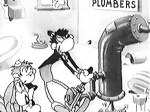 JOINT WIPERS (4/23)
JOINT WIPERS (4/23)
Direction: John Foster, George Stallings
Plumbers Tom and Jerry have a tough time unscrewing a stubborn bolt from a pipeline. At length Dawg (last seen in RABID HUNTERS) steps in and manages to remove it with his teeth! Just then an overweight woman phones Tom and Jerry so they can plug up a leak in her home. Dawg answers the phone, and a flood of water squirts out as he tries to tell our boys of the job. Tom and Jerry pack up their tools and jump on their wagon, but their horse gets distracted and leaves them in the middle of the road. Our heroes next jump in their bathtub (!) — but it doesn’t convey them any faster, leaving them to travel by foot.
Tom and Jerry arrive at the lady’s apartment via safety ladder. They sing We’re Glad That We’re Plumbers as drops of water play the tune on the piano. Then they plug the leak with a piece of chewed gum — but the plug doesn’t last. The leak begins flooding the apartment, despite Tom’s and Jerry’s feverish efforts to repair it. Sardines and statues jump in the water for a swim; a parrot floats in a cup singing Sailing, Sailing. As our boys desperately hammer at the pipe, the water slowly takes the house apart — then goes on to flood the entire city!
Our boys plummet down past numerous bathtubs and land in the newly-created lake. There they sing a final chorus of We’re Glad That We’re Plumbers, only to be razzed by the parrot, whom they pursue underwater.
A classic among the Van Beuren Tom and Jerry shorts, JOINT WIPERS is chock full of fine gags and great musical moments. JOINT WIPERS is also notable for having been made into a hardbound children’s book in 1932. Consisting of frame-blow-ups and text, the book is one of the only examples of Tom and Jerry merchandise that is known to us.
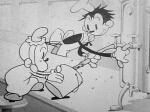 POTS AND PANS (5/14)
POTS AND PANS (5/14)
Direction: John Foster, George Rufle
Tom and Jerry run a successful diner. Business starts early in the day as Tom gives an infant a bucket of milk, and Jerry fries two eggs for an irrate customer. An effeminate man gruffly requests salt, while a tough-looking character speaks in a sissy falsetto. While Jerry fixes doughnuts for customers, a seemingly fat man orders a cup of coffee. When nobody is looking, however, “Fatty” opens his coat – revealing several little tykes inside, who instantly snatch the doughnuts and coffee!
Some angry customers pound on the table requesting soup. As Tom serves them, they begin to sing; sausages and pots of coffee dance in rhythm. Tom plays the cash register like a piano, while Jerry and the customers grab coffee pots and chairs and play them like trombones. The rhythm is so wild, it causes the diner to roll down a hill and collide with an oncoming train! Surprisingly, the train is demolished, while the diner remains unharmed.
Tom and Jerry exhibit little personality in POTS AND PANS; acting more or less interchangeably, they could be any pair of characters. However, this short has some excellent rubber hose animation – better than the usual Van Beuren product. The music is hot and peppy and the gags are exceptional.
 THE TUBA TOOTER (6/4)
THE TUBA TOOTER (6/4)
Direction: John Foster, George Stallings
A ship leaps through the sea to Hi-Lee, Hi-Lo and Oh Where, Oh Where. It’s bringing Schultz, a German tuba player, and his dachshund Fritz back home after an unspecified trip. Schultz’s flut, clarinet, – and sax-playing band partners welcome him at the dock and escort him home. There, Schultz offers Fritz liver so the dog will yodel as Schultz practices.
Schultz’s tuba music (Schultz Is Back Again) awakens his napping neighbors, Tom and Jerry, who jump out of bed and play the piano in tune. A cat claps a rhythm for mice to dance, a parrot claps for leaping sausages, and a fish for a wedge of cheese. Local crowds loudly cheer for Schultz and his music — a little too loudly, as the police arrive to arrest him for disturbing the peace. As the paddy wagon rolls away, Tom and Jerry hitch a ride in the bell of Schultz’s tuba.
Oompah groups were a favorite theme of 1920s songwriters, with Schultz Is Back Again following on the earlier hit Schultz’s German Band. It’s hard not to enjoy Van Beuren’s tribute to the craze. Pity we cannot speak as positively of Tom and Jerry’s female neighbors, whom our boys call to join the crowd toward the end of the short. These are some of the ugliest “sexy” women on record.
 PLANE DUMB (6/4)
PLANE DUMB (6/4)
Direction: John Foster, George Rufle
“If we make this nonstop flight to Africa, we’ll be heroes!” says Tom as he pilots a small plane through the sky. Passenger Jerry expresses doubts about being safe in Africa, so he and Tom use blackface makeup to disguise themselves as blacks, speaking in 19th century black dialect to complete the illusion. No sooner are their costumes finished, though, then the plane runs out of gas and falls into the ocean below.
Tom and Jerry emerge from the water and use a plane wing as a raft. An octopus climbs aboard with them, hugging them in its tentacles. “I told you I didn’t want to go to Africa,” whimpers Jerry. “Wait a minute, is we IN Africa?” grumbles Tom. “Does it ever look like we is ever gonna GET to Africa?… Then what have you got to kick about?” The boys are scared by sharks and a swordfish, then catapulted onto the jungle shore by a whale’s spout.
Tom and Jerry hide from wild animals in a dark bat cave, where Tom blames Jerry for whistling and clutching at him – only to find that the clutching hands belong to black skeletons, who sing Jerusalem Mournin’ (in animation reused from WOT A NIGHT). Emerging from the cave, Tom and Jerry are surrounded by cannibals who give chase. Fleeing for their lives, our boys wipe off their makeup; it’s done them no good.
 PLANE DUMB is an unusual cartoon. Van Beuren originally planned it, under the title ALL WET, to star cartoon versions of black comedians F. E. Miller and A. L. Lyles (famed on Broadway for the musical “Runnin’ Wild”). For whatever reason, though, the studio ended up reworking the short as a standard Tom and Jerry entry. Miller and Lyles’ characters already looked somewhat like Tom and Jerry in blackface; all that was necessary was to create a new frame story, explaining why the normal Tom and Jerry might need to black up and talk like Miller and Lyles. For the most part, it works — until you realize that the “disguised” characters have big lips that mere makeup couldn’t simulate. Their personalities change, too: Miller, as Tom, is a tough-talking cynic rather than the usual coward, whereas Lyles, as Jerry, is cowardly instead of cool.
PLANE DUMB is an unusual cartoon. Van Beuren originally planned it, under the title ALL WET, to star cartoon versions of black comedians F. E. Miller and A. L. Lyles (famed on Broadway for the musical “Runnin’ Wild”). For whatever reason, though, the studio ended up reworking the short as a standard Tom and Jerry entry. Miller and Lyles’ characters already looked somewhat like Tom and Jerry in blackface; all that was necessary was to create a new frame story, explaining why the normal Tom and Jerry might need to black up and talk like Miller and Lyles. For the most part, it works — until you realize that the “disguised” characters have big lips that mere makeup couldn’t simulate. Their personalities change, too: Miller, as Tom, is a tough-talking cynic rather than the usual coward, whereas Lyles, as Jerry, is cowardly instead of cool.
REDSKIN BLUES (7/23)
Direction: John Foster, George Stallings
Native Americans gallop in circles around Tom and Jerry’s stagecoach as the parties exchange fire. The coach gets wrecked, but the boys use clubs to fend off the flying arrows and tomahawks. They then escape up a cliffside via a makeshift ladder. The Indians fly up after them, using their headdresses as wings. Tom and Jerry are caught and tied to stakes before the fat, cloaked Chief.
As Indian girls dance around the stakes, Tom and Jerry play xylophone music on the firewood at their feet. Just before the firewood is set aflame, Jerry blows a horn to call for rescue; the cavalry, planes, tanks and even ships arrive. The Chief is captured, but only until he unleashes his secret weapon — a mouse. The vermin is seen as such a threat that the armed forces flee instantly, leaving Tom and Jerry to “hop” home, still tied to the stakes.
An unremarkable wild west cartoon is improved by the comedy of the unexpected. Numerous seemingly fat, cloaked Indians are unwrapped to reveal beautiful girls; when the cavalry leader uncloaks the Chief, he’s revealed as a Jewish caricature. The Jewish Indian was a standard vaudeville gag at the time, in part the result of Fanny Brice’s hit song on the theme (I’m an Indian).
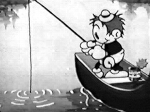 JOLLY FISH (8/19)
JOLLY FISH (8/19)
Direction: John Foster, George Stallings
Tom and Jerry go canoe fishing. As they paddle their way downstream, a fish leaps out of the water to hug and kiss Jerry, who must fend her off. Our baffled duo notice musical notes emerging from the water; the source turns out to be an octopus playing six pianos at once! A swordfish leaps from the lake and saws the boys’ canoe in half, giving them separate boats. While Jerry makes a string of worms to lure a minnow out of the lake, Tom swims underwater and tries to catch ducks. But once he brings the birds ashore, they fly off en masse, leaving Tom to shout “Gee whiz!”
Jerry sinks his line, and the worm on board looks for possible fish victims. Trying to lure an infant fish to the line, the worm is caught by a much larger fish who then ties Jerry’s and Tom’s fishing lines together. The fish tugs the lines and our heroes begin to reel in their “catches” — only to learn they’ve been had.
Tom and Jerry argue, each suspecting the other set him up. But unknown to our boys, Jerry’s line is still in the water. It attracts a sardine; then a larger fish that eats the sardine; then an even larger fish, and finally a huge one. Tom and Jerry climb ashore, reel in the huge fish, and march home happily whistling. They don’t notice that first the huge fish, then the progressively smaller fish are dropping off their line one by one, leaving them with only the original sardine.
Although JOLLY FISH does not meet the high standards set by Fleischer’s earlier TWENTY LEGS UNDER THE SEA, it’s still a highly imaginative short featuring several clever gags. The worm business in particular would be reused in later cartoons from various studios. Heard on the soundtrack: By the Beautiful Sea.
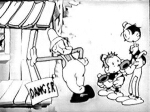 BARNYARD BUNK (9/16)
BARNYARD BUNK (9/16)
Direction: John Foster, George Rufle
The Great Depression has hit a rundown farm owned by a Farmer Alfalfalike farmer. As the old man sleeps on his porch, objects around him begin to break down. Finally hordes of Terryesque mice destroy the awning under which the farmer is napping — applying a helpful “Danger” sign at the last minute!
Just then saxophone salesmen Tom and Jerry happen by the farm. The farmer is indifferent to their music (“Aw, nuts!”), so the duo decide to show him how useful saxophones can be. Their jazzy tunes soon have the farmer’s chickens laying eggs, his cow churning out milk, and his woodpeckers chopping wood to the beat. The music even brings the farmer a nice, frothy mug of beer. Consuming it, the old man jumps up and down exclaiming “Whoopee!”
Enraptured Tom, Jerry, and the farmer dance on the farmhouse’s front path, creating xylophone-like sounds. The farmer invites our heroes inside, opening his safe and paying for the saxophones with a huge sack — of cash, one would think. Our content chums carry the sack outside; but when they open it, millions of mice emerge and toss Tom and Jerry into the lake!
Buoyed by an excellent Gene Rodemich score, BARNYARD BUNK is an above-average Van Beuren short, featuring the kind of flowing animation many entries lack. BARNYARD BUNK is also notable for having been excerpted — in our own day and age — as part of a recent Blue Cash commercial. The same commercial also features a scene of Famous Studios’ Wolfie delivering his signature “nyah, nyah, nyah”. Most frequently heard theme on soundtrack: Wabash Blues.
 A SPANISH TWIST (10/7)
A SPANISH TWIST (10/7)
Direction: John Foster, George Stallings
It’s a dull day at sea as castaways Tom and Jerry drift on a raft, bedeviled by a slingshot-toting octopus. The waves hurtle them to shore, where they hear La Paloma and realize they’ve landed in Spain. The tune comes from a beachfront cafe, where a waitress does the shimmy and a goony-looking band plays music. Our boys join the waitress in a dance, with Tom using a spoon to play xylophone on a lady diner’s backbone!
Everything comes to a halt when Tom and Jerry crash into the waitress’ boss. The man summons his two pet bulls to eject our heroes, but Tom and Jerry beat the bulls up instead. The boss is furious: “In this country, this is a big insult! Now you must fight… THE BULL!” It’s not explained why fighting one bull is a good punishment for beating two, but never mind: Jerry agrees to the boss’ challenge (“Hooray!”), while cowardly Tom tries to cover Jerry’s mouth… too late!
In the bullring the waitress throws our boys a rose. But romance turns to fear as a whole team of bulls appears on the field. A number of the group stand in formation on each other’s shoulders, allowing Jerry to push them all over on their faces. Tackling the rest of the herd, Tom runs between some like a quarterback, while Jerry spars with others like a boxer. The fight is interrupted in the end, though, when a bewhiskered messenger man arrives — giving Tom and Jerry notice that Prohibition has been repealed! Our booze-hungry heroes rush to their raft and head homeward.
One of the funniest Tom and Jerrys produced, A SPANISH TWIST has all of the series’ trademarks: Tom’s cowardice, Jerry’s chutzpah, eccentric band members, outrageous animals and unsexy sexy girls. The gag timing is better than usual and some effects animation — the ocean waves, the bull team’s acrobatics — is handled very well.
 PIANO TOONERS (11/11)
PIANO TOONERS (11/11)
Direction: John Foster, George Rufle
Tuners in a piano store, Tom and Jerry fool around after hours by playing and singing Margie. When Tom’s piano hits a sour note, he pulls the key out to its full length — like a long, ridiculous frog’s tongue — and cuts off its loose end. Mice emerge from other pianos in the shop and dance on the keys, playing Chopsticks. While Jerry squirts rat poison at the mice, Tom plays East Side, West Side and hits another sour note. This time the note is a sentient, squealing critter whom Jerry grabs and flushes down an offscreen toilet!
That night at the concert hall, “Mlle. Pflop” is to appear in concert. Helped by her cute blonde assistant, the fat Pflop dresses in her evening gown, then starts to sing and play the piano on stage. When her piano goes sour and “dies,” the question arises: “is there a piano tuner in the house?” Tom and Jerry volunteer, then test the piano with stethoscopes and doctor’s equipment. An ill-sounding key is extracted with pliers like a loose tooth. Fixing the piano, Tom strikes up Doin’ The New Low-Down, jointed by the orchestra, Mlle. Pflop’s assistant, and Pflop herself — who bursts up through the concert hall roof for a noisy finale.
It’s still hard to dislike such a wonderfully crazy short such as PIANO TOONERS. Pflop is grotesquely risqué as she changes into her evening gown, and her assistant is an unusual attempt to design a Betty Booplike character (with the addition of Fleischer’s own Bonnie Poe serving as the character’s voice).
 PENCIL MANIA (12/9)
PENCIL MANIA (12/9)
Direction: John Foster, George Stallings
Tom busily paints a dancing cow’s portrait until Jerry comes by to demonstrate his new magic pencil. He draws an egg in thin air which falls on Tom’s head. Tom chases Jerry and grabs the pencil, but can’t seem to make it draw. So Jerry returns to work; first creating a pair of odd, dancing birds, then a sax which he wildly plays. Tom is increasingly stunned. Next Jerry sketches a tomato, a potato, and a banana, all of whom sing Yes, We Have No Bananas.
Jerry transforms the tomato and potato into an 1890s boy and girl, and the banana into the typical 1890s villain. A chase begins; the boy and girl run for cover in a house, which Jerry transforms into a car. When the couple kisses, their enemy pops out of the rumble seat — only to have the girl punch him. The couple run up a ladder to a plane, but the villain shoots it down. After the fall, the contemptible cur knocks the boy out and puts him on some handy railroad tracks. Angry Tom punches the villain out so that he lands on the tracks, too.
The train arrives; but as it reaches the end of the tracks — apparently drawn with the pencil — it vanishes into space! Tom punches the villain again, this time reducing him to a blob of ink. The girl exclaims “My Hero!”; Tom coyly considers a relationship. Alas, Jerry appears and sucks the girl back into his pencil! Tom tears the scene away and chases Jerry off into the distance for the finish.
An interesting little short, PENCIL MANIA starts off strong; but the 1890s lampoon takes time that might have been better used to show further creative competition between our heroes. It’s a shame, as the drawings-come-to-life premise is just too good to be wasted.


 David Gerstein is a historian, writer, editor, and graphic designer. His books include Mickey and the Gang (the Disney Good Housekeeping pages), Nine Lives To Live (Felix the Cat) and the Floyd Gottfredson Library (Mickey Mouse comic strips). He is currently an editor of Disney Comics for IDW.
David Gerstein is a historian, writer, editor, and graphic designer. His books include Mickey and the Gang (the Disney Good Housekeeping pages), Nine Lives To Live (Felix the Cat) and the Floyd Gottfredson Library (Mickey Mouse comic strips). He is currently an editor of Disney Comics for IDW.




























